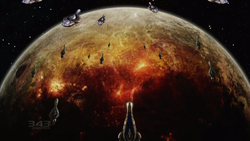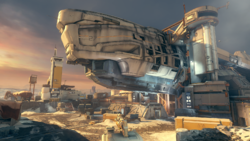Human colonies
From Halopedia, the Halo wiki


This article is part of a series on
Humanity
- Technology
- History
- Culture, Politics & Economy
- Biology
To check out information for other sapient species, see here!
Under the administration of the Unified Earth Government, humanity has surveyed and colonized several hundred worlds across a portion of the Orion Arm of the Milky Way galaxy over 200 years of superluminal travel via slipstream space, following nearly three centuries of expansion across the Sol system. The planets under the jurisdiction of the UEG, together with humanity's homeworld, are collectively referred to as "Earth and Her Colonies".[1][2] Human space is divided into three regions: the Sol system itself, the Inner Colonies, and the Outer Colonies.
History[edit]
Prehistory[edit]
- Main article: Prehistoric human civilization
Over 110,000 years ago, humanity was an advanced, spacefaring race, and had colonized thousands of worlds across the Orion Arm of the galaxy. However, after being exhausted by the parasitic Flood and eventually suffering a disastrous defeat against the Forerunners in the human-Forerunner wars, the Forerunners forcibly regressed humanity to a Tier 7 species and all traces of this advanced civilization were erased.
Interplanetary age[edit]
- Main article: Early history of the UNSC
The concept of space colonization was born out of the need to expand human habitation outside of Earth to prevent overpopulation, to alleviate the consumption of Earth's resources by conducting planetary mining on other worlds, and to better understand the universe as human civilization expanded. Various approaches were suggested to achieve this, such as colonization efforts of the Moon and Mars, building facilities on orbiting asteroids and creating artificial platforms.
The first recorded success of human colonization in the modern age was made in the later half of the 21st century, more specifically in 2080. The Moon and Mars saw humanity's first expansion, followed by a number of asteroids and the natural satellites orbiting Jupiter. The rapid pace of interplanetary colonization was driven by commercial interests more than the efforts on the part of national governments: Earth bio- and nanotechnology corporations sought to conduct scientific research unhindered by Earth's international law as well as its gravity. Mars, in particular, quickly became an important hub of leading-edge science and industry, and would continue to be so for hundreds of years, particularly in the area of spaceship manufacturing. Advancements in terraforming technologies transformed many of the formerly inhospitable planets and moons of the Solar System into worlds capable of sustaining life.[3]
Despite these successes, the efforts did not solve Earth's overpopulation issue. It eventually led to political unrest, contributing to the formation of political movements promising independence from the national governments on Earth and the perceived oppression by the United Nations.[4] Operating across the colonized worlds and orbital platforms of the Sol system, the Frieden movement and the Koslovics were the most prominent of these rebel factions. Beginning with a Frieden attack on the United Nations Colonial Advisors in the Jovian Moons and the subsequent UN response, battles were fought over the colony worlds—as well as Earth itself—from 2160 to 2170, culminating in a UN victory in the Interplanetary War. The outcome of the space wars led to the establishment of the Unified Earth Government as a centralized governing body tasked to ensure Earth's influence over the colony worlds and a powerful, united military force known as the United Nations Space Command.[4]

Expansion beyond Sol system[edit]
- Main article: Domus Diaspora
The technological innovation of the Shaw-Fujikawa Translight Engine in 2291 sprung the human civilization into the space-faring age, allowing them to travel beyond Sol system. In 2362 CE, the UEG constructed its first line of colony ships - led by Odyssey - to initiate the expansion of human habitation, relieving the growing pressure of overpopulation on Earth and the off-world colonies across the Sol system.[4] To manage governance in the extrasolar colonies as well as to ensure their security from pirates and other threats, the UEG established the Colonial Administration Authority and the Colonial Military Authority in 2310.[5] Two centuries later, both bodies would be marginalized—the latter due to widespread insurgent sympathies in its ranks—and eventually absorbed into the UNSC's emergency military government in 2525.[6]
Domus Diaspora[edit]
- Main articles: Domus Diaspora, Inner Colonies, Outer Colonies
As faster-than-light travel was still new and highly expensive, potential colonists were subjected to rigorous physical and mental testing to determine their suitability for the extrasolar colonization programs. As such, the colonists who formed the basis for the 210 first-wave colonies settled before 2390 formed humanity's elite; these worlds would later be known as the Inner Colonies. Earth and the Inner Colonies soon became the political and economic basis of the UNSC as humanity began expanding to the Outer Colonies.[4] For humanity at large, this was a time of unparalleled prosperity and optimism which has later come to be referred to as the "Golden Age" of human colonization,[7] a period which would eventually come to a violent end in the later years of the 25th century.[8]
By the time the settlement of the Outer Colonies began, many of the initial difficulties of interstellar travel had been alleviated; by extension, the selection criteria for the colonists became far more lax, resulting in the populace of the Outer Colonies being far more varied than that of the prestigious Inner Colonies.[8]
Colonial expansion continued and by 2490, UEG colonial space encompassed over 800 colonies in the Orion Arm, including planets, moons, asteroids, mining facilities, and relay stations.[9] The success of colonization of the Outer Colonies made the Inner Colonies the primary stronghold, both military and economic, though they relied heavily on raw materials supplied by the Outer Colonies. During this period, the planet Reach (orbiting Epsilon Eridani, right on Earth's metaphorical doorstep) became the UNSC's primary naval yard and training academy. Reach was a major producer of warships and colony vessels, as well as a training ground for covert operatives and Special Forces.
Insurrection[edit]
- Main article: Insurrection
The Inner Colonies' reliance on the Outer Colonies prompted the Unified Earth Government to maintain its hold over the Outer Colonies, but it inevitably began to lose its ability to do so as the Outer Colonies eventually surrounded the core worlds and far surpassed them in number. The overbearing influence of the Earth government, enforced by the UNSC and, initially, the Colonial Military Authority, led to a growing secessionist sentiment among Outer Colony citizens. The more radical elements of this movement took up arms against the UNSC, sparking a series of brushfire wars—collectively known as the Insurrection—in the late 2490s.[8]
The Covenant War[edit]
- Main article: Human-Covenant War
On April 20, 2525, contact with the Outer Colony, Harvest, was lost. After failing to re-establish contact with Harvest, the Colonial Military Authority sent a scout ship, the CMA Argo, to investigate. Contact with the Argo was subsequently lost after the ship arrived in the Harvest system, plunging humanity into a deadly war with an alien hegemony known as the Covenant. Harvest was bombarded from orbit in a process which would come to be known as glassing, marking the beginning of a 28-year war with the Covenant. During the war, hundreds of human colonies were destroyed and billions of human civilians and military personnel were killed by the Covenant. The conflict would see the near-annihilation of the Outer Colonies by the mid-2530s, with the Covenant flooding into the Inner Colonies until they destroyed humanity's military stronghold of Reach in 2552. At that point, humanity only had a few dozen colonies remaining in total.[10] The Inner Colonies narrowly avoided annihilation before the UNSC finally achieved victory against the Covenant in the same year, but communication and unity among Earth's surviving colonies had been utterly compromised amidst the galaxy-wide devastation.
Post-war[edit]
 This section is a stub. You can help Halopedia by expanding it.
This section is a stub. You can help Halopedia by expanding it.
Following the conclusion of the war, an extensive reconstruction process began in order to rebuild humanity's shattered colonial empire. With hundreds of worlds having been razed by the Covenant, numerous advanced pioneer groups were comissioned by the UEG to begin surveying and charting new potential habitable worlds, such as Eudemon.[11] In addition to new worlds, colonists began returning to previously-glassed worlds to begin the extensive process of "de-glassing"; digging up the glass to prepare the planet for re-terraforming. Several large corporations including Liang-Dortmund[12] and BXR were involved in these efforts, employing large scale mining machinery and thousands of people - by the time the reconstruction process is done, the corporations will own land rights to entire planets. The vitrified soil and other minerals on the surface of glassed worlds also proved to be a valuable source of revenue for these corporations, though questions remained about the ethical status of digging up and selling the glassed remains of entire cities and their occupants.[13][14]
By 2558, a number of former-colony worlds were involved in such de-glassing elements including Bliss and Meridian.[12] Biko was also at least partially re-settled, and a number of settlers returned to Reach by to begin the process of restoring their homeworld.[15] By 2589, Reach had been re-terraformed to some degree and open for re-settlement.[16]
The absence of the Covenant threat in the post-war era also marked a resurgence in insurrectionist and secessionist activity, with worlds including Venezia rejecting Earth's offers of cooperation, accusing the UNSC of abandoning them during the war.[17] The UEG and Sangheili both administrated Joint Occupation Zones where the Shadow of Intent participated in combined anti-piracy operations with UNSC forces between May 6 and June 1.[18] In early 2558, the region experienced in upsurge in Jiralhanae raids due to the Jiralhanae's dwindling resources.[19]
Government and politics[edit]
While the Unified Earth Government is technically a confederation of equal, independently-governed worlds, this is not true in practice;[20] the interests of Earth and the Inner Colonies weigh more heavily in the government's decision-making than those of the Outer Colonies. This has led to tensions and even civil war between the UNSC and the outer settlements,[21] which many of the Inner Colonies relied on for their foodstuffs and resources.[4]
Various organizations exist to provide military defense for the colonies. The Colonial Authority originally provided most security forces for outer colonies, and managed the CAA Marshals as "frontier sheriffs", and the Colonial Military Authority - a military force originally created for the colonies but eventually sidelined due to widespread corruption.[22] The CMA's role was taken over by the United Nations Space Command, which many colonists resent due to its perceived draconian influence. For colonies which merited them, the UNSC Army is the primary force tasked with the defence of colonies. A given Army detachment on a colony is managed by that colony's Army Component Command (ACC), which oversees the administrative side of Army operations on the planet. As colonies were destroyed during the war with the Covenant, ACCs were temporarily disestablished and replaced with sector-level working groups based on Reach and Earth. The Army additionally operates its own reserve units and Army Security Forces to aid in the defence of colonies.[23]
Some colonies maintain their own territorial defense forces, including Sedra's Colonial Guard, as well as the Gao Republic's military. Anti-UNSC sentiments are not uncommon among these organizations, some of which—such as the Venezian militia—are openly secessionist. The UNSC also operated its own Colonial Militia program to train colonial citizens to deal with emergencies as well as local rebellion.[24]
Many colonies are named after locations on Earth, while others receive more descriptive or abstract names. Some worlds are only known by their astronomical designation, with the name of the star the world orbits followed by a numeric designation most often rendered in Roman numerals. On some colony worlds such as New Jerusalem, the capital city shares its name with the planet, as it is common for a colony's initial population center to be considered synonymous with the colony itself.[25] The Earth Survey Catalog also exists to document various extrasolar planets, assigning them identification codes.[26]
Scale[edit]
As of 2490, human-controlled space encompassed around 800 colonized sites, including planets, moons, asteroids and various other outposts. The colonies ranged from heavily-populated and economically, politically and strategically significant worlds to struggling pioneer outposts which could barely sustain 10,000 colonists. Some worlds were terraformed to greater degrees than others depending on the local conditions and presence of indigenous life.[20] Many of the colonies were firmly under the influence of the UEG with some seeking to secede from humanity's empire.[4] The worlds are generally divided among the stable Inner Colonies and the more numerous and restless Outer Colonies, and are highly diverse in terms of culture; some worlds have their foundations in the cultural heritage of a single Earth nation, while others have more varied population bases.[27] After the Human-Covenant War, some worlds became even more heterogeneous with the emigration of former Covenant client species to the human sphere.[28]
The Inner Colonies encompassed a region of space in at least a 10.5 light-year three-dimensional radius from Earth. Beyond that were the Outer Colonies. Other colonies were established even further - Coral, at 42 light-years;[29] and Madrigal, the most distant known colony, which lay in the 23 Librae system, 83.7 light-years from Earth.[30] Despite its relatively short distance from Earth, at approximately 12 lightyears, Harvest was considered the furthest Outer Colony in 2525, at six weeks of Slipspace travel away from Madrigal and two months from Reach.[31] Despite its relative scale, humanity's empire takes up only a minuscule portion of the Milky Way galaxy itself, all human-colonized systems existing within a bubble of 100 light-years around Sol in contrast to the overall scale of the galaxy which is 100,000 light-years in diameter.[32][Note 1] However, humans often use the word "galaxy" in colloquial speech when describing humanity's sphere of influence.[33]
The following is a list of all populated star systems in human space with a known stellar location, categorized in relation to how distant they are from Sol in light-years:
- Sol system: 0
- Luyten 726-8 system: 8.7
- Epsilon Eridani system: 10.5
- Lacaille 9352 system: 10.74
- Procyon system: 11.46
- Groombridge 34 system: 11.7
- Tau Ceti system: 11.9
- Epsilon Indi system: 12
- Eridanus system: ~20-30
- XI Boötis A system: 21.8
- Beta Hydri system: 24.4
- Zeta Tucanae system: 28
- Groombridge 1830: 29.7
- Gamma Pavonis system: 30.1
- Zeta Doradus system: 38
- Lambda Serpentis system: 38.3
- Lambda Aurigae system: 41.2
- CE-2-1239 system: 42
- Alpha Aurigae system: 42.2
- Theta Ursae Majoris system: 45
- 18 Scorpii system: 45.7
- 26 Draconis system: 46
- 111 Tauri: 47
- Psi Serpentis system: 47.8
- Alpha Corvi system: 49
- 51 Pegasi system: 50
- Cygnus system: 52
- Kolaqoa system: ~69-76 (58 light-years from Epsilon Eridani, 24 light-years from Cygnus)
- Chi Ceti system: 76.9
- 23 Librae system: 85
- Algol system: 92.8
- Alpha Imura system: 135 (if it is synonymous with the Gamma Piscium system)
- Cordoba system: exact value unknown (8.7 light-years from the Shaps system)
- Shaps system: exact value unknown (8.7 light-years from the Cordoba system)
List of known colonies[edit]
Pre-Human-Forerunner war[edit]
Post-Great Purification[edit]
- Main article: Great Purification
Solarian colonies[edit]The Sol system is home to the centre of human space, and almost all of the planets, moons bodies within the system have been settled or industrialised in some form or another.
Extrasolar colonies[edit]Outliers[edit]The locations list below represent locales that have been mentioned to be the site of various human colonies, though their contextual mentions are not clear as to whether they are fully-fledged planets or merely individual settlements on a planet.
| |||||||||
Non-canon and dubious canon appearances[edit]
Silver Timeline[edit]
| This article contains information about the Silver Timeline, and is not a part of the established Halo canon. |
Humanity has numerous colonies beyond Earth. They are divided into Inner and Outer Colonies as well as numbered FLEETCOM Sectors.
| Name | System | Established | Status | Position | Source |
|---|---|---|---|---|---|
| Reach | Epsilon Eridani system | Glassed 2553 | Inner Colony | ||
| Eridanus II | Eridanus system | 2440 | Attacked 2552 | ||
| Madrigal | 23 Librae system | Glassed | Outer Colony | ||
| Mamore | Outer Colony | ||||
| Criterion | Attacked 2552 | ||||
| Barrier Moon | |||||
| Sigma Octanus IV | |||||
| Sanctuary | Glassed 2553 | ||||
| Aleria | |||||
| Oban | |||||
| Tribute | Inner Colony | ||||
| Estuary | Glassed |
Production notes[edit]
There remains some debate about whether humanity settled worlds outside the Sol system before Reach, which was colonized by the Odyssey in 2362 and marked the beginning of the Domus Diaspora. The original Xbox.com timeline and The Impossible Life and the Possible Death of Preston J. Cole state that colony ships were built beginning in 2310, and the Halo Encyclopedia (2022 edition) states extrasolar colonies Juneou and Titus had colonization dates of 2330 and 2355 respectively. An explanation as to why humanity unveiled their ships in 2310 and then waited 52 years to start the colonization process has yet to be given, beyond "decades of planning".[51] Most sources state that the Odyssey was the very first colony ship and Reach the very first colony.
Notes[edit]
- ^ All identified real-world stars housing human colonies are within dozens of light-years of Sol. The original edition of Halo: The Fall of Reach suggested that humanity had colonized the Beta Centauri system, which is 350 light-years away. The 2010 reprint removed the reference to Beta Centauri, evidently because of the distance being deemed too long for the system to be feasible as a human colony. Therefore it can be assumed that all human-colonized systems are closer to Sol than Beta Centauri's 350 light-years.
- ^ Jump up to: a b c d e f g h i j k l m n o p q r s t u v w x y z aa ab ac ad ae af ag ah ai aj ak al am an ao ap aq ar as at au av aw ax ay az ba bb bc bd be bf bg bh bi bj bk bl bm bn bo bp bq br bs bt bu bv bw bx by bz ca cb cc cd ce cf Halo: Oblivion establishes that the Outer Colonies are considered to have truly begun with the establishment of Alluvion in 2412. As such, this table assumes the Inner/Outer Colony status of all worlds based on their described settlement date. However, this is not a hard boundary; some colonies such as Falaknuma were settled well beyond this date and are considered Inner Colonies, and some colonies settled closer to the early-mid 2400s may nonetheless have some overlap. The inner/outer assumptions described above are denoted by the presence of this note.
- ^ While Barugi was first settled in 2460, it shares its star system with Nephis - a world settled in 2381 - making both presumably a part of the Inner Colonies.
- ^ Based on the proximity to other Outer Colony systems such as the Cordoba system.
Sources[edit]
- ^ Halo 3, campaign level Halo
- ^ Halo: The Fall of Chapter, ??
- ^ Halo Encyclopedia, p. 42 (2011)
- ^ Jump up to: a b c d e f Xbox.com, Halo Storyline: (Additional copy on HBO Forums) (Retrieved on Apr 24, 2008) [local archive] [external archive]
- ^ Halo 4: The Essential Visual Guide, page 228
- ^ Halo Story Page, Frank O'Connor/Robt McLees Interview - August 2008 (Retrieved on Jun 1, 2020) [archive]
- ^ Halo: Evolutions, "The Impossible Life and the Possible Death of Preston J. Cole", p. 415-416
- ^ Jump up to: a b c Halo: Evolutions, "The Impossible Life and the Possible Death of Preston J. Cole", p. 428-429
- ^ Halo Mythos, p. 54
- ^ Halo Mythos, p. 85
- ^ Halo Waypoint, The Halo Bulletin: 10.25.12 (Retrieved on Nov 16, 2012) [archive]
- ^ Jump up to: a b Halo 5: Guardians, campaign level Meridian Station
- ^ Tumblr, BENJAMIN_GIRAUD_ENTRY_0384 (Retrieved on Jun 25, 2016) [local archive] [external archive]
- ^ HUNTtheTRUTH, season 1, episode Episode 11: Down to the Bone
- ^ HSoR
- ^ Halo: Reach, campaign level Lone Wolf
- ^ Halo: Glasslands, page 70
- ^ Halo Waypoint, Catalog Interaction - Page 14 (Retrieved on Jun 1, 2020) [archive]
- ^ Halo: Escalation, issue #1
- ^ Jump up to: a b Halo Encyclopedia, p. 43 (2011)
- ^ YouTube, Halo: From A to Z with Frank O'Connor (Retrieved on Jun 1, 2020) [archive]
- ^ Halo Encyclopedia (2022 edition), page 54-55
- ^ Halo Encyclopedia (2022 edition), page 61
- ^ Halo: Contact Harvest, chapter 66
- ^ Halo Waypoint: Canon Fodder - That Escalated Quickly
- ^ Halo: Combat Evolved: Sybex Official Strategies & Secrets, page 64
- ^ Halo: Contact Harvest, page 61-62
- ^ Halo: Nightfall - Chapter One
- ^ I Love Bees
- ^ Halo: The Cole Protocol, ??
- ^ Halo: Contact Harvest, ??
- ^ An Inside Look at Halo: Warfleet – A Guide to the Spacecraft of Halo. "...do we also wanna have a map of UNSC space that's more centralized on Sol? Maybe shows like, you know, a hundred light year radius around Earth."
- ^ Hunt the Truth
- ^ Halo: Fleet Battles, Scenario One: Flight!
- ^ Halo: Point of Light, chapter 1
- ^ Halo Encyclopedia (2011 edition), page 300
- ^ Jump up to: a b Halo: Evolutions - The Impossible Life and the Possible Death of Preston J. Cole
- ^ Halo: Saturn Devouring His Son
- ^ Halo Wars: Genesis
- ^ Halo 3, multiplayer map Waterfall
- ^ Halo 5: Guardians, campaign level Osiris
- ^ HUNTtheTRUTH, season 2, episode Episode 02: From Fire to Blood
- ^ Halo: Official Spartan Field Manual, page 113
- ^ Halo: From the Soil to the Stars
- ^ Halo Infinite, High Value Target dossier, Zeretus, Battle Officer
- ^ Halo: Empty Throne, chapter 7
- ^ Halo: Empty Throne, chapter 9
- ^ Cite error: Invalid
<ref>tag; no text was provided for refs namedOsiris - ^ Halo Encyclopedia (2022 edition), page 110
- ^ Halo 4 Infinity Challenge and Global World Championship enlistment verification emails
- ^ Halo Encyclopedia (2022 edition), page 21




